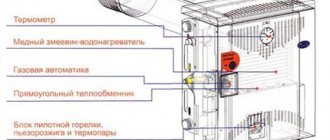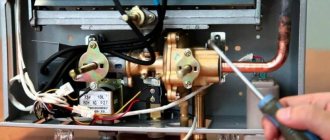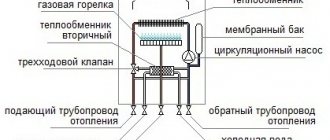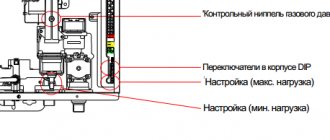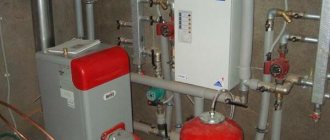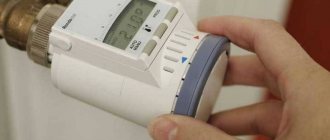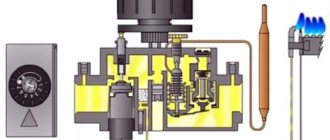Gas boilers are reliable equipment that supply our country houses and some city apartments with heat and hot water. Unfortunately, they cannot work completely without breakdowns. And violations often include valves—devices for protecting and supplying fuel to units.
We will tell you how and what kind of gas boiler valve repairs you can do yourself. We will analyze in detail the situations that signal the occurrence of related disruptions in work. We’ll tell you whether it’s worth making your own efforts or whether it’s better to turn to gas workers.
In our article you will find step-by-step guides to restoring the performance of gas boilers by repairing or replacing the gas, safety and three-way valves.
EGC device
The gas solenoid valve consists of electrical and mechanical elements. Electrical parts control the system, and mechanical parts execute commands. The device circuit is located in the housing.
Solenoid valve design:
- frame;
- plunger;
- solenoid (electric coil);
- piston;
- stock;
- lid.
Due to the fact that gas safety shut-off valves have a low operating pressure, they are most often made of metal and alloys (cast iron, brass, aluminum), as well as polymers (nylon, ecolon, polypropylene).
Plungers and rods are made from special magnetic materials. The coils use a sealed housing that protects against dust and short circuits. The winding of the solenoids is made with high-quality enameled wire, for which electrical copper is used.
The device is connected to the gas pipeline with a flange or threaded connection, and is connected to the electrical network with a plug.
Let's consider the main advantages
- Efficient operation of the system on different types of gas supply.
- The system does not require connection to the electrical network.
- There is a starting gas filter and a special screw to regulate the fuel supply.
- Possibility of operation of the device at low gas pressure.
- Function to turn off the system when there is insufficient draft or when back smoke occurs.
- Stable temperature conditions.
- Possibility of smooth adjustment.
- Piezo ignition is modeled to make the device as simple and convenient as possible during operation.
- Constant outlet pressure.
- Simple design and compact dimensions of the device.
Principle of operation
The EGC is a hydraulic element that regulates gas flow by applying voltage to a valve coil.
The operating principle of the gas valve is the same as that of a conventional faucet. The gas is shut off at the touch of a button. If harmful and strong vibrations occur or gas leaks, it closes automatically.
The core, connected to the saddle of the device, is drawn into the coil by the acting electromagnetic forces and opens the access of gas. During operation, the device is affected by two forces. On the one hand, this is the resistance of the return spring, and on the other, the strength of the magnetic field, which is regulated by electrical voltage. The stronger it is, the greater the force that overcomes the action of the spring. Therefore, adjusting the voltage supply makes it possible to increase or decrease the degree of opening or closing of the device, and therefore the gas supply. This allows you to adjust the performance of the unit by increasing or decreasing its power.
When the power is turned off, the EGC returns to its original position, which is determined depending on the design.
ความคิดเห็น • 0
Yeah, but if the dielectric is pierced between the thread and the central terminal, it will also indicate a short circuit
Thank you! The parts are similar to those of the AOGV 11.6 Rostov.
You're calling incorrectly
I soldered the thermocouple directly at the contact point, and I never have any more problems with it.
The video is certainly old, but questions will still arise. I’ll share my experience, and then it’s up to everyone. I start the test by inspecting the thermocouple while the pilot light is burning. The igniter flame should flow well around the tip of the thermocouple, and the thermocouple itself should be intact without any damage or indentations. The tightness of the contacts between the thermocouple and the electromagnet is also checked. The union nut 14 must be tightly tightened on the thermocouple side and on the side of the draft sensor and temperature fuse. You can ring the right side of the electromagnet, which is responsible for the temperature and traction sensor, using an indicator screwdriver. In the AOGV kit, they sometimes sell a plug for the right side of the magnetic box (as they say in the spare parts catalog), then you can check the serviceability of the electromagnet by screwing on this plug and igniting the pilot burner. If after this the electromagnet “does not grab” and does not attract the round core with the rod inside, then you need to check the contacts that Magomed Khamzalatov wrote about by examining them and trying to rotate them relative to the electromagnet body (they should be firmly soldered). As an option, sometimes I remove the thermocouple along with the electromagnet and the round core, heat it on a gas burner and test it in action. I beg to differ with Magamed regarding the aging of the membrane, because... when it becomes stale, the igniter ignites without pressing the start button, and in some cases it can cause a gas leak above the gas block. Solder the threads carefully, because... The gasket between the contact tin and the cut threaded tube is made of plastic and can melt. You can also check the functionality of the magnet using a AA battery, then you won’t have to heat anything on a gas burner.
Thank you! Make your own channel on YouTube!!
I made a special bracket and now I have it pressed all the time and I don’t care, but buying a new one is a waste of money.
The gas will disappear and the fuse will blow out Pisa for everyone
It is not rational if, for example, the flame is blown out by the wind, and the gas continues to flow to the burners and spread throughout the house.
Greetings! Where can I buy a thermostat for AGV 80?
This coil works on simple Aogv boilers, what is the advantage of accessibility, ease of replacement and repairs to faults are visible to the naked eye, and it can be done directly easily, but it’s better not to do it, call mechanics and they’ll do everything
Better yet, call the mechanics and replace the boiler.
Good afternoon. We need your professional advice. Why does the steam stop on the steam table when you turn on (press the button) the steam iron, but when the button is turned off, the steam flows. (It should be in reverse) In my opinion, the solenoid valve works in reverse. Why. Thank you in advance.
If you have replaced the solenoid valve with Eurosit 630, it would be interesting to watch the video. Thank you.
Application of EGC
Gas valves are widely used in everyday life and industry. In the industrial sphere, they are used in equipment ensuring gas safety, in earthquake detection systems, and can be installed in parallel with gas alarm equipment.
In everyday life they are used to control the supply of gas to dispensers, gas boilers, stoves, and when introducing pipes into residential high-rise buildings. They are equipped with gas cylinders when installing automobile gas cylinder devices.
Designed for pipelines with non-aggressive media, including natural gas, propane, liquefied petroleum gas (LPG).
Gas boiler room equipment with PTVM boiler.
Let's consider the gas equipment of the PTVM-120
with
GTRU-1000
.
The boiler has 16 burners, divided into four groups. One of the burners in the group is a pilot burner. Each burner has its own igniter, and the pilot burner has a control electrode for the burner torch. Figure 1 shows the gas pipelines of a boiler room with a PTVM-120
.
The gas-air fittings of each burner include:
- fan;
- igniter;
- pilot valve;
- high voltage transformer;
- torch control electrode (only for pilot burners);
- RRP for gas (only for pilot burners);
- PRZ by air (gate);
- burner air pressure sensor;
- working gas cut-off device EGR.
Types and groups of gas valves
EGCs differ in design features, which determines their classification:
- by type of execution - normally closed or normally open;
- by type of working medium - for water, gas, air, steam, fuel;
- according to operating features - conventional and explosion-proof;
- according to the principle of action - direct, indirect, combined.
Depending on the number of strokes of the saddle, the devices are:
- single-stage or one-pass.
The valve can be in the open or closed position. Having received an electrical signal, it opens completely and ensures the passage of the required amount of fuel; - two-stage or two-pass.
EGC may be in an intermediate position. This is necessary for a smooth start of the burner. The valve, which is partially opened, opens completely after a certain time and ensures the operation of the equipment in the maximum permissible mode. Partial opening results in a stable flame on the burner; - three-stage or three-way.
This type of solenoid valve is equipped with devices with 2 power levels. In this design, the first stroke starts the unit, the second repeats the functions of the first stage of two-stage devices, and the third ensures that the equipment operates at full power; - modulating.
In this case, the device is equipped with modulating gas valves in which the seat opens to a user-specified position.
According to the type of control, valves are:
- with manual control.
These are simple designs whose shutter is activated by turning a control wheel or lever. Such devices are highly reliable and low cost; - automatic.
The design of such models is equipped with an electric drive, which allows you to control the device from a distance. Most often used in industrial facilities: gas pipelines, heating networks, production lines.
Based on their functional purpose, the following types of gas valves for boilers and other devices are distinguished:
- back.
Protects the pipeline from gas circulation in the opposite direction. A check valve mechanism allows current to flow in only one direction; - safety.
It is a protective device that prevents emergency situations due to a sharp pressure drop in the gas pipeline.
Manufacturers
Let's look at the most popular companies that produce gas valves.
Dungs
A German company that is one of the most popular in the production of gas control valves.
Dungs products began appearing on the Russian market in 1999 and were able to firmly consolidate their position. Users constantly purchase products from this manufacturer because they are distinguished by high quality, reliability and long service life.
Double gas valve device DUNGS type DMV
The only drawback that can be noted is the high price.
The most technologically advanced development of the Dungs company in the mass segment is the Dungs DMV-D valve - this is a two-way device, which, in fact, is a connection of two independent valves in one compact body. Thanks to its technical characteristics, it can function in high pressure working environments (up to 500 mbar). The cost of devices starts at approximately 12,000 rubles.
Benefits and Features
The device differs:
- reduced energy consumption;
- long service life;
- reliability of the design, which ensures convenience and ease of operation.
The main feature of the product is that you do not need to apply any effort to open and close the valve. The control is carried out by an electromagnetic coil, which is triggered by the supply of electric current. EGC's automatic response to emergency situations makes the use of natural gas safe.
The second feature of the solenoid valve is the ability to clean the working environment from small solid particles: dust, organic debris, metal shavings.
Room thermostat saves gas
To automatically control the temperature in the house, boiler manufacturers recommend using a room or weather-compensated controller with a continuous principle of controlling the boiler flow temperature.
You can also use a room thermostat of a two-position principle (ON/OFF), but with less efficiency.
Boilers of luxury categories, as a rule, are immediately equipped with a remote control unit. Installed on the wall of the room, such a unit allows you to remotely control and monitor the operation of the boiler, and also serves as a room thermostat.
A room regulator allows you to maintain a constant temperature in a heated room with high accuracy. With manual control, the range of temperature fluctuations is larger and deviations are more often towards higher temperatures. Every extra degree in the room leads to an increase in gas consumption for heating. In addition, using a thermostat, you can program an automatic decrease in the temperature in the house during certain periods (at night...). Refusal of manual control of heating temperature and installation of an automatic regulator to maintain the required temperature in the room can significantly reduce gas consumption for heating.
In addition, to change the boiler settings, the owner does not have to run to the boiler room. Custom boiler settings can be changed right in the house, on the thermostat.
A room thermostat or room temperature sensor is always installed in the largest room of a house or apartment.
Room thermostat saves energy
When the boiler operates without a room thermostat, the circulation pump runs constantly, consuming electricity. The room thermostat controls not only the gas burner, but also the circulation pump. The circulation pump, controlled by the room thermostat, operates intermittently, which saves energy and the life of the pump.
How to choose the right model?
To choose the right device, you need to decide where it will be used and what characteristics it should have.
When purchasing, you need to pay attention to the following properties:
- electrical service.
It is desirable that the device be intrinsically safe, low power, with additional manual adjustment; - pressure.
When choosing a valve, it is necessary to take into account that the pressure in the system should not be higher than the nominal pressure of the device. Otherwise, the mechanism may be damaged; - external environment.
Environmental conditions (humidity, temperature changes, exposure to ultraviolet radiation, vibration) must match the characteristics of the device. External factors can adversely affect the entire device and its individual elements; - network voltage.
It is necessary to pay special attention to this indicator, since low or high voltage can lead to incorrect operation of the mechanism or its failure; - connecting dimensions.
When purchasing, you must take into account the diameter and type of thread, which must correspond to the parameters of the main pipeline.
Ignition transformer
This element supplies the burner with a current discharge (spark), which is necessary to ignite the fuel. In addition to other elements that directly affect the operation of the unit, the component can also fail. As a result, all automation will work, but fire will not appear, since there is no source of ignition.
How can you quickly check the ignition transformer of a gas boiler for functionality? Just. You need to make a few simple movements:
- Through a special window, see whether the discharge is going on or not.
- Using a tester, check the voltage coming out of the controller during the ignition attempt. A figure falling within the range from 187 to 235V is considered normal.
- If a problem is detected, you need to disconnect the power from the transformer and connect it back.
- Check again.
Any gas boiler is equipped with many safety elements and sensors that allow you to monitor the correct operation of the unit. In the event of situations that clearly threaten human life, the system completely shuts down the installation.
In case of any breakdown, most owners of a gas water heater call a specialized service technician. However, services usually come with financial costs, right?
Installation of the device
The installation of a shut-off valve into the gas system must be carried out by specialists who have special approvals that allow them to perform this type of work and other permitting documentation.
The installation location is selected so that there is easy access to the device for manual cocking.
It is recommended to install EGC:
- in front of the gas meter, if the design allows;
- in front of a gas appliance: stove, boiler, water heater;
- at the system entrance to the room where there is a gas meter with a shut-off mechanism. The distance from the entry point must be more than 10 m.
Installation may require additional consumables, which must be purchased in advance.
Connection of solenoid valves must be carried out in compliance with all manufacturer’s recommendations and adhere to the requirements of standards and regulations.
Diagram of gas equipment for boilers DKVR, DE.
Layout of shut-off devices for gas equipment of the DKVR
with two burners is shown in the following figure.
1 - gas manifold; 2 - branch to the boiler; 3 - disconnecting device; 4 - slam-shut valve
on the boiler;
5 - regulating gas valve; 6 - gas igniter; 7 - charger
in front of the burner; 8 — gas burner; 9 - safety gas pipeline; 10 — purge gas pipeline; 11 - pressure gauge.
In many existing boiler houses there is no purge gas pipeline; the boiler gas pipelines are purged through gas pipeline 9.
Cast iron valves with manual drive are used as locking devices 3, 7.
Gas flow is regulated using throttle valves (VD)
or low resistance dampers
(LDR)
, actuator -
MEO
or similar type.
A PKN
is used as the executive body of the safety automatics (4) - the shut-off valve .
Where to buy EGC?
If you are interested in high-quality solenoid valves, please contact. Our catalog includes a wide range of industrial drive equipment from European manufacturers. We offer a large selection of sensors, automation systems, recorders and power supplies for various purposes.
You can make a purchase from our company without much difficulty. The prices for gas appliances will pleasantly surprise you, and registration will require a minimum amount of time.
For additional information about gas valve models and their characteristics, please contact our managers by calling +375 (17) 513-99-92.
KSU-2P control kit.
The following modifications are available for boilers operating on gas fuel:
- KSU-2P-1-G (as part of control and signaling units BUS-1 and switching element unit BKE-1) - for boilers with natural circulation with vacuum;
- KSU-2P-2-G (as part of blocks BUS-2 and BKE-1) - for boilers with natural circulation with pressurization;
- KSU-2P-3-G (as part of blocks BUS-3 and BKE-2) - for direct-flow boilers with supercharging.
The supply voltage of the kit is a three-phase network 380/220 or 220/127 V with fluctuations ranging from +10 to -15%. The supply voltage is set using jumpers on the block located in the control and signaling unit (BUS). AC frequency 50 ± 1 Hz. Power consumption no more than 300 VA.
KSU-2P, together with sensors and actuators, provides: two-position regulation of the main technological parameters of the boiler (stabilization of the water level in the drum - for KSU-2P-1-G and KSU-2P-2-G; stabilization of steam pressure - for all modifications); safety automatics (gas supply to the boiler is stopped in case of emergency decrease and increase in gas pressure, decrease in air pressure, increase in steam pressure at the boiler outlet, absence of burner flame, emergency increase and decrease in the level in the boiler drum - for KSU-2P-1-G and KSU-2P-2-G, lowering the vacuum in the boiler furnace - for KSU-2P-1-G, in case of an emergency increase in the temperature of the steam at the boiler outlet and the temperature of the exhaust gases - for KSU-2P-3-G); light and sound alarms with storage of the root cause of the accident; issuing signals to the control panel about turning on the set and stopping the boiler; automatic start and stop; working alarm.
The BUS contains functional blocks. On the front panel of the BUS there are operational control and alarm controls (figure below). In addition, the BUS includes intermediate relays used to control the boiler actuators and magnetic starters of the BKE unit 16, as well as to switch the BUS circuits during the execution of the control program.
